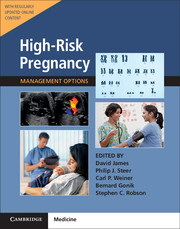Book contents
- High-Risk Pregnancy: Management Options
- High-Risk Pregnancy: Management Options
- Copyright page
- Contents
- Contributors
- Section 1 Prepregnancy Problems
- Section 2 Early Prenatal Problems
- Section 3 Late Prenatal – Fetal Problems
- Section 4 Problems Associated with Infection
- Chapter 24 Hepatitis Virus Infections in Pregnancy (Content last reviewed: 23rd July 2019)
- Chapter 25 Human Immunodeficiency Virus in Pregnancy (Content last reviewed: 23rd July 2019)
- Chapter 26 Rubella, Measles, Mumps, Varicella, and Parvovirus in Pregnancy (Content last reviewed: 11th November 2020)
- Chapter 27 Cytomegalovirus, Herpes Simplex Virus, Adenovirus, Coxsackievirus, and Human Papillomavirus in Pregnancy (Content last reviewed: 11th November 2020)
- Chapter 28 Parasitic Infections in Pregnancy (Content last reviewed: 15th June 2018)
- Chapter 29 Other Infectious Conditions in Pregnancy (Content last reviewed: 11th November 2020)
- Section 5 Late Pregnancy – Maternal Problems
- Section 6 Late Prenatal – Obstetric Problems
- Section 7 Postnatal Problems
- Section 8 Normal Values
- Index
- References
Section 4 - Problems Associated with Infection
Published online by Cambridge University Press: 15 November 2017
- High-Risk Pregnancy: Management Options
- High-Risk Pregnancy: Management Options
- Copyright page
- Contents
- Contributors
- Section 1 Prepregnancy Problems
- Section 2 Early Prenatal Problems
- Section 3 Late Prenatal – Fetal Problems
- Section 4 Problems Associated with Infection
- Chapter 24 Hepatitis Virus Infections in Pregnancy (Content last reviewed: 23rd July 2019)
- Chapter 25 Human Immunodeficiency Virus in Pregnancy (Content last reviewed: 23rd July 2019)
- Chapter 26 Rubella, Measles, Mumps, Varicella, and Parvovirus in Pregnancy (Content last reviewed: 11th November 2020)
- Chapter 27 Cytomegalovirus, Herpes Simplex Virus, Adenovirus, Coxsackievirus, and Human Papillomavirus in Pregnancy (Content last reviewed: 11th November 2020)
- Chapter 28 Parasitic Infections in Pregnancy (Content last reviewed: 15th June 2018)
- Chapter 29 Other Infectious Conditions in Pregnancy (Content last reviewed: 11th November 2020)
- Section 5 Late Pregnancy – Maternal Problems
- Section 6 Late Prenatal – Obstetric Problems
- Section 7 Postnatal Problems
- Section 8 Normal Values
- Index
- References
Summary
Intra-amniotic infection/inflammation (IAI) is a frequent and important cause of spontaneous preterm labor and delivery. Indeed, it is the only pathologic process for which both a causal link with spontaneous preterm birth has been established and a molecular pathophysiology defined. Fetal infection/inflammation has been implicated in the genesis of fetal and neonatal injury leading to cerebral palsy (CP) and chronic lung disease. Pathologic intra-amniotic inflammation can occur in the absence of detectable microorganisms, upon analysis by cultivation and/or molecular microbiologic techniques. This condition is known as sterile intra-amniotic inflammation and has been observed in patients with preterm labor and intact membranes, preterm prelabor rupture of the membranes (PPROM), and a short cervix. A mild sterile inflammatory process also participates in spontaneous labor at term, but this is considered to be an example of physiologic inflammation similar to that implicated in other important events in reproductive physiology, such as ovulation and implantation.
- Type
- Chapter
- Information
- High-Risk PregnancyManagement Options, pp. 579 - 602Publisher: Cambridge University PressFirst published in: 2017



